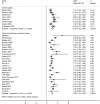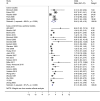Smoking and Suicide: A Meta-Analysis
- PMID: 27391330
- PMCID: PMC4938402
- DOI: 10.1371/journal.pone.0156348
Smoking and Suicide: A Meta-Analysis
Abstract
Background: Many studies have reported a positive association between smoking and suicide, but the results are inconsistent. This meta-analysis was carried out to estimate the association between smoking and suicidal ideation, suicide plan, suicide attempt, and suicide death.
Methods: Major electronic databases including PubMed, Web of Science, Scopus, and ScienceDirect were searched until May 2015. The reference lists of included studies were screened too. Epidemiological studies addressing the association between smoking and suicidal behaviors were enrolled. The heterogeneity across studies was explored by Q-test and I2 statistic. The possibility of publication bias was assessed using Begg's and Egger's tests and Trim & Fill analysis. The results were reported based on risk ratio (RR) and odds ratio (OR) with 95% confidence intervals (CI) using a random-effects model.
Results: We identified a total of 8062 references and included 63 studies with 8,063,634 participants. Compared to nonsmokers, the current smokers were at higher risk of suicidal ideation (OR = 2.05; 95% CI: 1.53, 2.58; 8 studies; I2 = 80.8%; P<0.001), suicide plan (OR = 2.36; 95% CI: 1.69, 3.02; 6 studies; I2 = 85.2%; P<0.001), suicide attempt (OR = 2.84; 95% CI: 1.49, 4.19; 5 studies; I2 = 89.6%; (P<0.001), and suicide death (RR = 1.83; 95% CI: 1.64, 2.02; 14 studies; I2 = 49.7%; P = 0.018).
Conclusions: There is sufficient evidence that smoking is associated with an increased risk of suicidal behaviors. Therefore, smoking is a contributing factor for suicide. Although this association does not imply causation, however, smoking prevention and cessation should be the target of suicide prevention programs.
Conflict of interest statement
Figures






Similar articles
-
Relationship of religion with suicidal ideation, suicide plan, suicide attempt, and suicide death: a meta-analysis.J Res Health Sci. 2022 Mar 2;22(1):e00537. doi: 10.34172/jrhs.2022.72. J Res Health Sci. 2022. PMID: 36511249 Free PMC article.
-
Alcohol-related risk of suicidal ideation, suicide attempt, and completed suicide: a meta-analysis.PLoS One. 2015 May 20;10(5):e0126870. doi: 10.1371/journal.pone.0126870. eCollection 2015. PLoS One. 2015. PMID: 25993344 Free PMC article.
-
The Role of Social Support in Preventing Suicidal Ideations and Behaviors: A Systematic Review and Meta-Analysis.J Res Health Sci. 2024 Jun 1;24(2):e00609. doi: 10.34172/jrhs.2024.144. Epub 2024 Jun 1. J Res Health Sci. 2024. PMID: 39072545 Free PMC article.
-
Substance use disorder and risk of suicidal ideation, suicide attempt and suicide death: a meta-analysis.J Public Health (Oxf). 2016 Sep;38(3):e282-e291. doi: 10.1093/pubmed/fdv148. Epub 2015 Oct 26. J Public Health (Oxf). 2016. PMID: 26503486
-
The role of problem-solving skills in the prevention of suicidal behaviors: A systematic review and meta-analysis.PLoS One. 2023 Oct 31;18(10):e0293620. doi: 10.1371/journal.pone.0293620. eCollection 2023. PLoS One. 2023. PMID: 37906576 Free PMC article.
Cited by
-
The prevalence of suicidal behaviour and its associated risk factors among school-going adolescents resident in the United Arab Emirates.Sci Rep. 2023 Nov 15;13(1):19937. doi: 10.1038/s41598-023-47305-3. Sci Rep. 2023. PMID: 37968503 Free PMC article.
-
The Prevalence of Psychiatric Distress and Associated Risk Factors among College Students Using GHQ-28 Questionnaire.Iran J Public Health. 2017 Jul;46(7):957-963. Iran J Public Health. 2017. PMID: 28845407 Free PMC article.
-
How Does COVID-19 Affect the Neurobiology of Suicide?Curr Psychiatry Rep. 2021 Mar 3;23(4):16. doi: 10.1007/s11920-021-01227-x. Curr Psychiatry Rep. 2021. PMID: 33660116 Free PMC article. Review.
-
Prototyping the implementation of a suicide prevention protocol in primary care settings using PDSA cycles: a mixed method study.Front Psychiatry. 2024 Jan 25;15:1286078. doi: 10.3389/fpsyt.2024.1286078. eCollection 2024. Front Psychiatry. 2024. PMID: 38333892 Free PMC article.
-
The role of substance use, smoking, and inflammation in risk for suicidal behavior.J Affect Disord. 2019 Jan 15;243:33-41. doi: 10.1016/j.jad.2018.09.005. Epub 2018 Sep 7. J Affect Disord. 2019. PMID: 30223137 Free PMC article.
References
-
- World Health Organization. Preventing suicide: A global imperative. Geneva: WHO; 2014.
-
- Centers for Disease Control and Prevention. Understanding suicide: fact sheet. 2013; http://www.cdc.gov/violenceprevention/pub/suicide_factsheet.html, 20 August 2013.
Publication types
MeSH terms
LinkOut - more resources
Full Text Sources
Other Literature Sources
Medical

